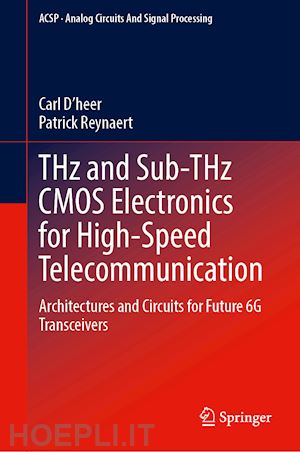
Questo prodotto usufruisce delle SPEDIZIONI GRATIS
selezionando l'opzione Corriere Veloce in fase di ordine.
Pagabile anche con Carta della cultura giovani e del merito, 18App Bonus Cultura e Carta del Docente
This book provides a complete overview of high-speed circuit design for high-speed telecommunication above 100GHz. Covering everything from telecom and electronics fundamentals to system-level modeling, detailed circuit design, and in-depth performance analysis, this book lends itself as the perfect design guide and reference work for beginner and experienced telecommunication circuit designers alike.
Chapter 1. Introduction.- Chapter 2. Fundamentals of Telecommunication.- Chapter 3. Basic Electronics and Components.- Chapter 4. High-Frequency Circuit Design.- Chapter 5. System-Level Considerations.- Chapter 6. A High-Speed 390GHz BPOOK Transmitter.- Chapter 7. A 135GHz Direct-Digital 16-QAM Wireless and DWG Link.- Chapter 8. Conclusion.
Carl D’heer was born in Deurne, Belgium, in 1995. He received the B.Sc. degree in electrical and mechanical engineering (magna cum laude) and the M.Sc. degree in electrical engineering (microelectronics) (summa cum laude) from KU Leuven in 2016 and 2018, respectively. His master’s thesis revolved around the design of a CMOS integrated optical radio receiver and earned him faculty’s best master’s thesis award. As part of his M.Sc program in electrical engineering, he attended one semester at Columbia University supported by the Melexis - Columbia scholarship. In 2018, he joined the MICAS Research Group, KU Leuven, Belgium, where he is currently pursuing the Ph.D. degree. In 2024, he joined Huawei Technologies Research and Development Belgium as a senior RFIC Design Engineer. His research interests include millimeter-wave/THz CMOS circuits and transceiver architectures for high-speed communication systems. He also serves as a reviewer for the IEEE Journal of Solid-State Circuits and the IEEE Solid-State Circuits Letters. He was the recipient of the Platinum (1st place) Award at the Huawei PhD Student Contest IC Design Benelux Edition in 2022.
Patrick Reynaert (Senior Member, IEEE) was born in Wilrijk, Belgium, in 1976. He received the Master of Industrial Sciences degree in electronics from the Karel de Grote Hogeschool, Antwerp, Belgium, in 1998, and the Master of Electrical Engineering and Ph.D. degrees in engineering science from the University of Leuven, Leuven, Belgium, in 2001 and 2006, respectively. From 2006 to 2007, he was a Post-Doctoral Researcher with the Department of Electrical Engineering and Computer Sciences, University of California at Berkeley, Berkeley, CA, USA, with the support of a BAEF Francqui Fellowship. In 2007, he was a Visiting Researcher with Infineon, Villach, Austria. Since 2007, he has been a Professor with the Department of Electrical Engineering (ESAT-MICAS), KU Leuven. His research interests include millimeter-wave and terahertz CMOS circuit design, high-speed circuits, and RF power amplifiers. Dr. Reynaert was a recipient of the 2011 TSMC-Europractice Innovation Award, the European Solid-State Circuits Conference (ESSCIRC)-2011 Best Paper Award, and the 2014 2nd Bell Labs Prize. He is the Chair of the IEEE SSCS Benelux Chapter. He serves or has served on the Technical Program Committee for several international conferences, including the International Solid-State Circuits Conference (ISSCC), ESSCIRC, Radio Frequency Integrated Circuits Symposium (RFIC), Conference on PhD Research in Microelectronics and Electronics (PRIME), and International Electron Devices Meeting (IEDM). He was an Associate Editor of the IEEE TRANSACTIONS ON CIRCUITS AND SYSTEMS I: REGULAR PAPERS and is an Associate Editor of the IEEE JOURNAL OF SOLID-STATE CIRCUITS.











Il sito utilizza cookie ed altri strumenti di tracciamento che raccolgono informazioni dal dispositivo dell’utente. Oltre ai cookie tecnici ed analitici aggregati, strettamente necessari per il funzionamento di questo sito web, previo consenso dell’utente possono essere installati cookie di profilazione e marketing e cookie dei social media. Cliccando su “Accetto tutti i cookie” saranno attivate tutte le categorie di cookie. Per accettare solo deterninate categorie di cookie, cliccare invece su “Impostazioni cookie”. Chiudendo il banner o continuando a navigare saranno installati solo cookie tecnici. Per maggiori dettagli, consultare la Cookie Policy.